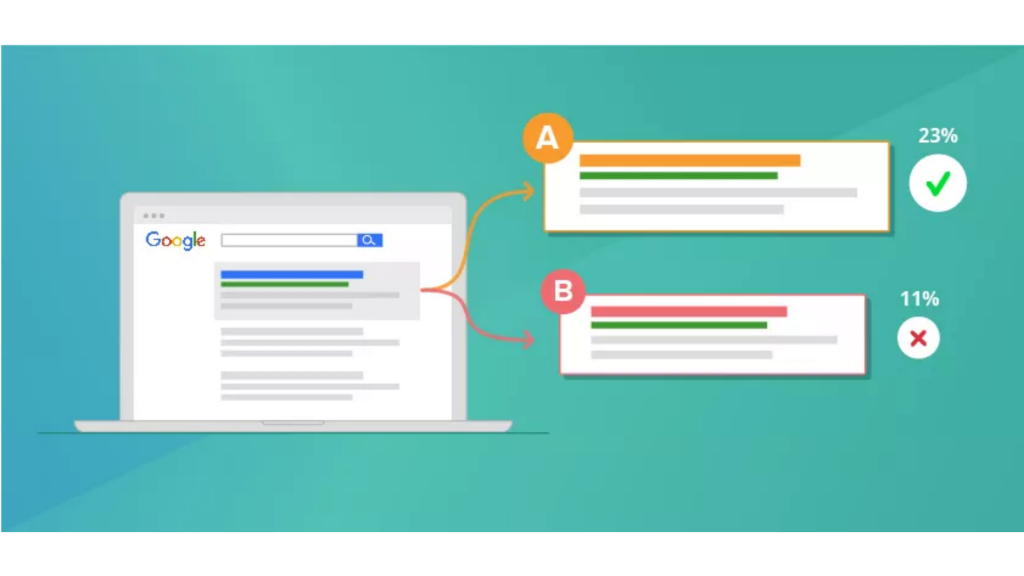As you’re probably aware (or maybe you’re not and that’s why you’re here), “marketing” isn’t just one thing. “Marketing” consists of MANY things all working together to create the desired outcome. That outcome can also be one of MANY different things.
If your goal is to inspire someone to take any action when they are on your website, viewing your social media accounts, reading one of your ads, etc., copy testing is a great way to figure out what works and what doesn’t.
What is copy testing?
Simply put, copy testing is when you use different text (copy) to convey the same message and measure which text performs best.
Ad copy testing is specific to, well, ads. You’re specifically testing copy in an ad as opposed to testing copy on a website page, a call-to-action button or a blog post title.
Ads come in all shapes and sizes. For example, you can run ads on Google, Facebook, Instagram, LinkedIn, Twitter, YouTube, Reddit, etc. to name a few.
Some placements allow you to have several lines of text. Others give you multiple headlines, space for a description and button text, like Facebook ads. Google ads offer many different “extensions” that allow you to customize your ad copy even further by adding details, pricing, promotions and other qualifiers so you can hone in on your audience.
Different ad platforms offer different ways to customize ad copy in order to help you improve your performance. If used correctly, great ad copy can make or break the performance of your ads. BUT, you have to measure your results. Avoid the method of writing one draft of copy, publishing it, crossing your fingers and hoping it does well.
It’s 100% okay to fail at first. If every first attempt we ever made was a slam-dunk, we’d never learn how to grow and be better.
If you fail, just dust yourself off and just try again. Fail forward, keep getting better, keep trying new things! Go forth and prosper!
Ad copy best practices
If you’ve never written ad copy before, you might be a little intimidated by the concept of it. But don’t fear, you don’t have to get it perfect the first or even the second time you do it.
That’s why you’re A/B test ad copy anyway, right?!
Here are some simple guidelines to follow in order to hit the ground running in a positive direction.
Know what your customer wants
You know your own business inside and out – and that’s great – but it’s not the point of your ad copy!
Your copy is meant to speak to your customers about the pain points that you can solve with your product or services.
Put yourself in their shoes and think about what problems they are facing. It’s your time to swoop in and tell your customers that their problems will soon be over.
Speak to your customers
Make them feel special! Address your audience with words like “you” and “your” in your ad copy.
Everyone wants to feel like their needs are being heard, so speak to them directly.
Play to their emotions
If you know your customer needs your product or service, remind them by stimulating their emotions. FOMO (fear of missing out) is a real thing – use it!
Instead of playing it safe, be a little outrageous. Leverage your audience’s biggest fears or worries. It’s better than looking like every other ad out there.
Add numbers
Numbers are finite and they tend to cause an immediate reaction whether good or bad.
Try incorporating a few numbers in your ad copy to really hone in on your message. Use a statistic, dollar amount or any other data point that will turn heads.
Be irresistible
Give them an offer they can’t refuse!
Think about the common push backs you get from your customers. Address those questions in your ad copy and your audience won’t have an excuse to scroll past your ad.
If your audience has nothing to lose by downloading a free offer or signing up for a free webinar, make sure you say that loud and proud.
Use the space you’re given
Use the entire character count to your advantage. Google gives you 30 characters plus an 80 character description.
Fill your ad space with as much information as possible to make sure you’re providing your audience with what they need.
Let your uniqueness shine through
Make sure your audience knows why you’re different from your competitors. This is your opportunity to brag about why you’re so freaking awesome.
Think about including these things in your ad copy:
- What does your business do better than or different from anyone else in the industry?
- Have you won any awards?
- Are you running any sales or making any special offers?
- What’s unique about your brand’s image?
Keep it local
If you’re a local business, highlight your location in your ad copy. People love to support a local business, so let them know that you’re a staple in the neighborhood.
If you have multiple locations, it would be beneficial to break out your campaigns based on geo-targeting so you can cater your ad copy to each location or area of service.
Use strong, action-oriented call-to-actions
“Call now” doesn’t really inspire excitement, does it? Don’t use the same tired CTAs on your ad, get more creative!
Choose words that are bold and inspire action! “Save,” “build,” “join,” “grow,” and “create” are all punchy verbs that make you want to click instead of scroll by.
A/B testing ad copy
One of the most common ways to test ad copy is with A/B testing. You may be familiar with the term split testing or bucket testing. Those are both synonymous with A/B testing.
A/B testing or split testing or bucket testing is a way to compare two versions of copy (or any other metric) against each other to see which variation performs better. The two or more variations are compared against each other and based on statistical analysis, the ad copy with a better conversion rate is deemed the winner. Huz-ah!
Cool, so what exactly does that look like?
Let’s say you have a Facebook ad that’s not performing too well. You decide you want to change the ad copy to see if you can improve the click-through-rate (CTR) on the ad. If you improve the CTR, more people will end up on the landing page you created to convert website users into leads or customers (depending on what you’re selling or offering).
You’ll start with the ad copy you’re currently using. This is called the control. Let’s say the control ad copy is:
“Sign up for a consultation with us today!”
You choose to test the control against the following test copy or the variant:
“Sign up for a FREE 30-minute business evaluation today!”
In order to properly test your copy, you’ll need to run two versions of the ad, one with the control copy and one with the variant.
All other elements of the ad must remain the same so you know that the ad copy is the only part of the ad that is different in the variant version. Other elements of the ad include the audience, geographical targeting, budget, image/video/creative elements, ad URL and the length of time the ad runs or is “live.”
Measuring your ad copy test results
Now that you’ve got your two sets of ad copy ready to go, the control and the variant/test, let’s run that test!
Like we discussed above, don’t change any other aspects of your ad EXCEPT the copy. If you change the ad copy AND another element of the ad, you won’t know which change impacted the results you see.
Was it the ad copy or the new video you used that caused that amazing increase in CTR? There’s no way to tell because we weren’t isolating just one element of the ad.
At this point, the test you just ran is null and void, and you’ll have to start from the beginning and test your ad copy and your new video in SEPARATE tests.
I’ll say it one more time for the cheap seats in the back, don’t test more than one thing at a time!
One other thing to consider as you launch your A/B test is which ad you want to test. If you have several ads running with different budgets, the ad with the largest budget might be the best one to test. I say this because the ad with the larger budget is most likely going to reach more people in the same time period that a smaller budgeted advertisement would. The larger the sample size you have to test your ad against, the better. So keep that in mind when you’re making your game plan for testing ad copy.
Now that you’re ready to test, you want to make sure that you run the test for at least seven days. You can always keep it running longer. But it’s always better to have more data than less in any situation. You can read a little more about how long to run an A/B test for in this article by Neil Patel
Depending on what platform you’re running the ad, you might be able to test your ad copy at the same time or you may have to run the control copy for one week then implement the variant copy for one week. I’ll talk a little more about that later on.
How do you choose a winner?
This is entirely dependent on your goals.
Are you trying to increase the Click-Through-Rate to a landing page? Maybe you’re trying to increase leads by promoting an offer you want someone to sign up for or download. Your ads might be driving people to make a sale right away (especially if you’re an eCommerce business) and you’re measuring the success of your ad by revenue and/or sales.
We ask our clients this all of the time, “what are your goals?” And the same goes for running an ad copy test. You need to have an intended goal or reason why you would want to test the copy or any element in the ad. You’re obviously trying to improve performance, but WHAT does improved performance look like for you and your business goals? That’s the golden ticket.
Based on the example we were using above with the Facebook ad copy and CTRs. If your control ad copy has a 2.4% CTR after seven days and the variant or test copy has a 3.1% CTR at the end of the seven days, you can deem the variant copy the winner!
The variant came out on top with a higher CTR, therefore, the test copy inspired more people to click on the ad and go to the landing page you have in place for that ad. Like I mentioned earlier if you would have changed the ad copy AND the video in the ad and the variant still won with the higher CTR, there would be no way of determining if it was the copy or the video that caused an increased CTR. Maybe it was both? Maybe it was just the video? There is no measurable way to tell when you don’t run a clean test that is only examining one element.
HubSpot has a great article on measuring the results of your A/B copy testing if you want to check it out here.

Moral of the story? Test your ad copy frequently to improve performance!
You’ve now been blessed with the keys to the ad copy testing castle. Take it and run!
In all seriousness, testing your ad copy (or any other element in your ad) is how you learn what is going to work and what isn’t.
Remember, you may not get it right the first time and that’s okay. Fail fast and forward. Keep making tweaks and improvements based on your goals. The fact that you’re here reading this post means you’re hungry for progress and positive results, so good for you!
If you think this is awesome but you don’t have the time to test ad copy yourself, hire us! We’d love to test your ad copy for you. 🙂



